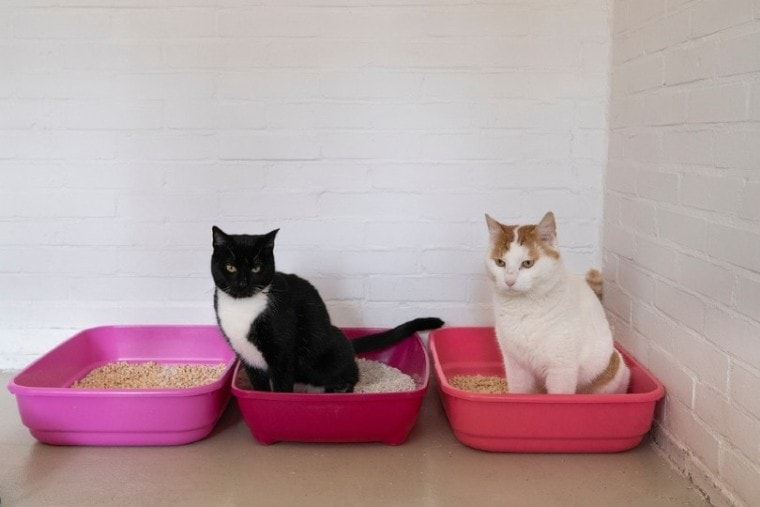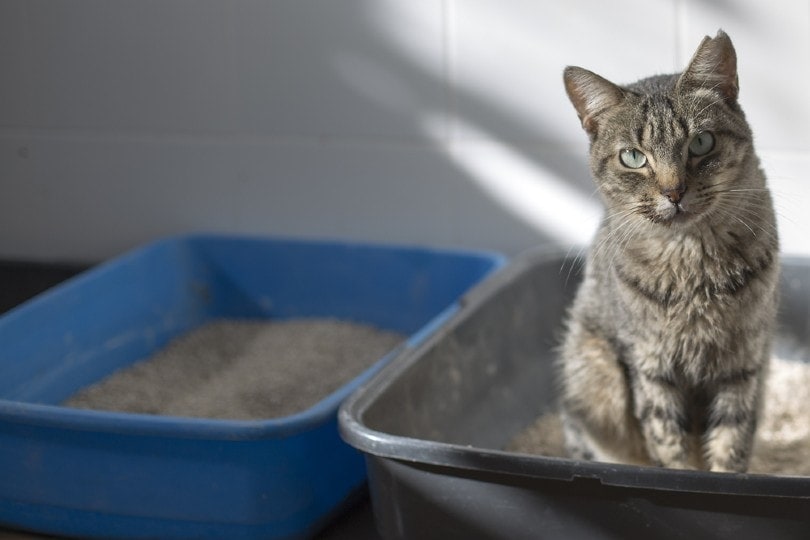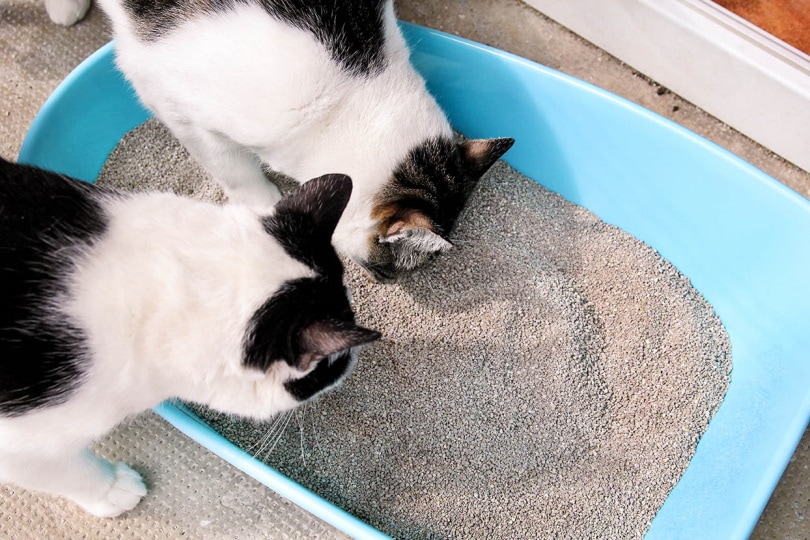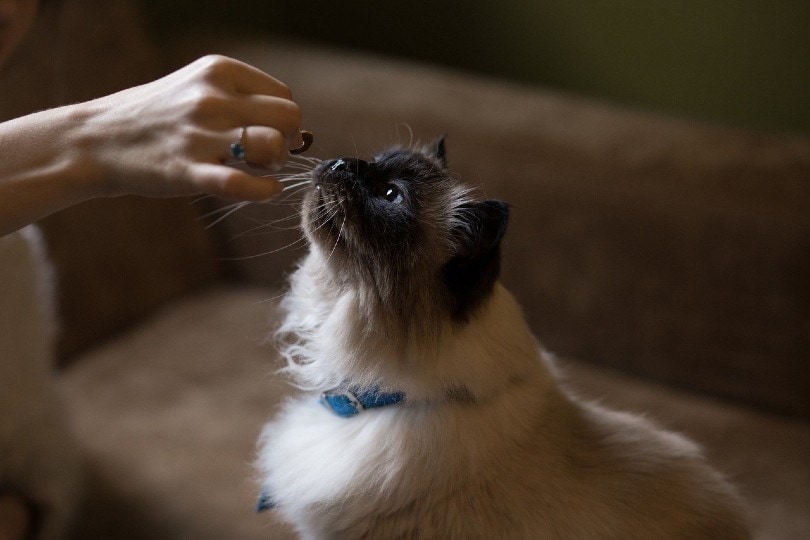
It’s no doubt that cats tend to be creatures of habit. A cat in a set routine may recoil from any type of change to their regular habits and environment. This can especially be true for elderly cats, who are often less adaptable than kittens.
However, there are many reasons you may want to introduce new litter boxes to the home. You may have new cats joining the family or would just prefer a box that is more suited for your home. There is a vast range of litter boxes that come in all shapes, sizes, and special functions, so you may be looking for something in particular.
Negotiating this change with your stubborn feline can pose some challenges, but you can set yourself up for success for a seamless transition. Take a look at our top five tips for how to transition a cat to a new litter box.
The 5 Tips for Transitioning Your Cat to a New Litter Box
1. Keep the Old Box

If your cat consistently uses their current litter box, they are likely pretty happy with it. Totally removing it from the scene may stress your cat out when it goes to releive itself and find it is gone, particularly if it is skeptical of its new box.
During the transition period, you should keep the old box exactly how it is. Keep it in the same place and filled with the same litter so your cat can use it until it gets used to the new addition.
The trick is to make the new litter box more attractive than the old one. Cats are clean animals, so they prefer to go to the bathroom in the fresh litter to ensure the new litter box is always clean. In addition, clean the old litter box less often, so it becomes less appealing to your cat. Once it becomes uncomfortable, they may venture to try out the new box.
Cats are eternally stubborn, so it may take some time, but with some patience and consistency on your part, they will realize the advantage of switching to the new box.
2. Location, Location, Location
In addition to being stubborn, cats are rather proud. Going to the bathroom is a vulnerable time for them, and they much prefer peace and privacy, so the location of their litter box is vital. Their litter box should be somewhere quiet and discrete.
Likely, their old litter box is in a good place if they use it happily, so your new box should be placed in this same area. If you are simply changing the litter box to the same size and shape as the old one, you could probably sneakily swap them out without your cat even realizing it.
More considerable changes to an entirely different box will require more patience. Placing the new box next to the old one will mean that your cat will become used to seeing it as they relieve themself. Over time your cat should start to recognize they serve the same purpose and consider trying it out.
If you put the new box in a brand-new location, you’re likely to confuse your cat and may find they pay zero interest in this new box.
3. Use Recognizable Scents

Scents are vital to cat communication. Consider their urine as their own personal brand or name tag that they leave messages to one another with. Items with your cat’s scent will be recognized by them as their own, so introducing their scent to the new box can be advantageous.
Mix a small amount of used litter into the litter of the new box to incorporate some familiar smells with the box. When your cat investigates, this comforting scent can help them feel more confident exploring the new box.
Even if you keep a clean and tidy litterbox, you probably still find yourself with cat odors and stains around the house – but with the Hepper Advanced Bio-Enzyme Pet Stain & Odor Eliminator Spray, you can permanently remove even the very worst pet stains and smells! Click here to learn more and get yourself a bottle.
- ADVANCED ENZYMATIC CLEANER - Penetrates the most stubborn smells and stains at the deepest molecular...
- FOR ANY MESS, ON ANY SURFACE - This pet odor eliminator cleans your carpets, floors, furniture,...
- FRESH, NATURAL ODOR - Our unique formulation doesn't rely on dangerous or unpleasant chemical...
At Pet Keen, we’ve admired Hepper for many years, and decided to take a controlling ownership interest so that we could benefit from the outstanding products of this cool cat company!
4. One Change at a Time
You may be looking at replacing a cat’s litter box as part of a more significant change to adjust where and how your cat toilets in the home. You may also be looking a changing the location of the litter box and the type of litter used also, but you mustn’t change too much at once.
Large changes to routines can confuse or scare cats that are incredibly set in their ways. They may not recognize their new litter box as something to use for toileting at all if it in no way resembles their box associated with their everyday habits.
When making changes, make sure that they are made in small kitty steps so your cat can adjust alongside them. It may be hard for us who like to see immediate change, but patience and perseverance will pay off long term in ensuring your cat maintains polite habits around the home.
5. Reinforce Good Behavior

Cats are notoriously hard to train and enforce manners with. They don’t tend to respond to praise or negative reinforcement of behaviors as they, quite frankly, do as they please.
So, unlike your dog, your cat may not respond to a “Good boy!” and a big pat when they do the right thing. In fact, touching and talking to them should be avoided around the litter box as they prefer to be left alone. Your presence could deter them from the new box.
Cats are intelligent enough to make connections between behaviors and positive rewards. If you hear your cat using their new litter box, hang out unseen nearby and when they finish, reward them with a small treat or a pat when they return. Over time, they will connect the dots when they get things they like after using the new box and are ignored after using the old one.
It’s important to note that you should never try to negatively reinforce when they use the old box. All you will do by punishing your cat is deter them from using the litter box at all, and you may find them toileting in unfavorable areas in the house.
In a Nutshell
Cats are profoundly independent and self-governing. Trying to force new behaviors on your cat will only end in frustration, so you need to be thoughtful about your approach to introducing a new litter box.
To set you and your cat up for success, you need to understand your cat’s motivations and comfort zone, so you ensure a flawless transition to a new box. Using these tips, you will find it hard to go astray, and your patience will be rewarded!
Featured Image Credit: Leoniek-van-der-Vliet, Shutterstock








